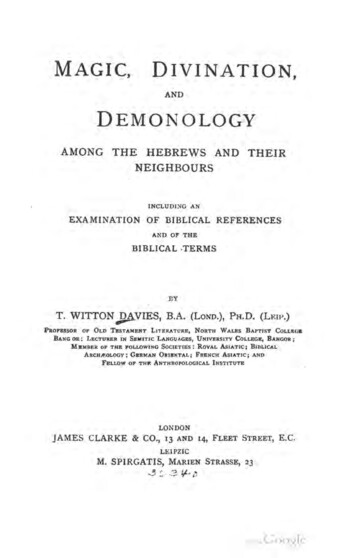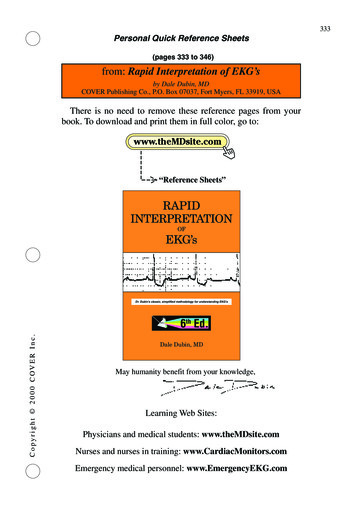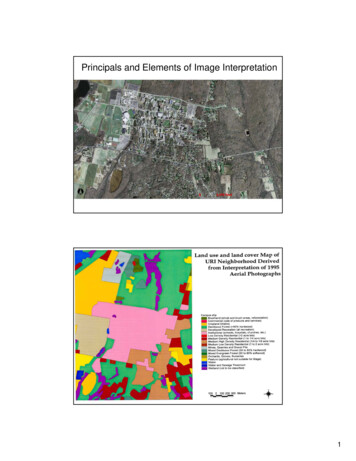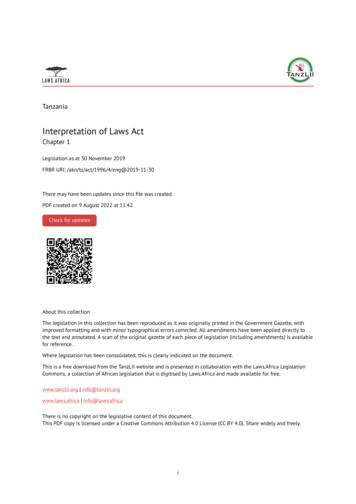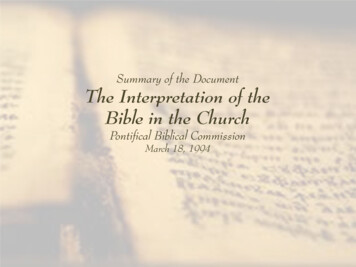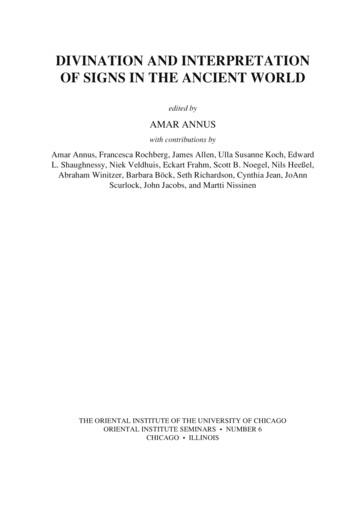
Transcription
iiiDivination and interpretationof signs in the ancient worldedited byAmar Annuswith contributions byAmar Annus, Francesca Rochberg, James Allen, Ulla Susanne Koch, EdwardL. Shaughnessy, Niek Veldhuis, Eckart Frahm, Scott B. Noegel, Nils Heeßel,Abraham Winitzer, Barbara Böck, Seth Richardson, Cynthia Jean, JoAnnScurlock, John Jacobs, and Martti NissinenThe Oriental Institute of the University of ChicagoOriental Institute Seminars Number 6Chicago Illinois
ivLibrary of Congress Control Number: 2009943156ISBN-13: 978-1-885923-68-4ISBN-10: 1-885923-68-6ISSN: 1559-2944 2010 by The University of Chicago. All rights reserved.Published 2010. Printed in the United States of America.The Oriental Institute, ChicagoThe University of ChicagoOriental Institute Seminars Number 6Series EditorsLeslie SchramerandThomas G. Urbanwith the assistance ofFelicia WhitcombCover Illustration: Bronze model of a sheep’s liver indicating the seats of the deities. From Decimadi Gossolengo, Piacenza. Etruscan, late 2nd–early 1st c. b.c. Photo credit: Scala / Art Resource, NYPrinted by Edwards Brothers, Ann Arbor, MichiganThe paper used in this publication meets the minimumrequirements of American National Standard for Information Services — Permanence of Paper for Printed LibraryMaterials, ANSI Z39.48-1984.
vTable of ContentsPreface . . . . . . . . . . . . . . . . . . . . . . . . . . . . . . . . . . . . . . . . . . . . . . . . . . . . . . . . . . . . . .viiIntroduction1. On the Beginnings and Continuities of Omen Sciences in the Ancient World . . . . . .Amar Annus, University of Chicago1section one: THEORIES OF DIVINATION AND SIGNS2. “If P, then Q”: Form and Reasoning in Babylonian Divination . . . . . . . . . . . . . . . . .Francesca Rochberg, University of California, Berkeley193. Greek Philosophy and Signs . . . . . . . . . . . . . . . . . . . . . . . . . . . . . . . . . . . . . . . . . . .James Allen, University of Pittsburgh294. Three Strikes and You’re Out! A View on Cognitive Theory and the FirstMillennium Extispicy Ritual . . . . . . . . . . . . . . . . . . . . . . . . . . . . . . . . . . . . . . . . . . .Ulla Susanne Koch, Independent Scholar435. Arousing Images: The Poetry of Divination and the Divination of Poetry . . . . . . . . .Edward L. Shaughnessy, University of Chicago616. The Theory of Knowledge and the Practice of Celestial Divination . . . . . . . . . . . . . .Niek Veldhuis, University of California, Berkeley77section two: HERMENEUTICS OF SIGN INTERPRETATION7. Reading the Tablet, the Exta, and the Body: The Hermeneutics of CuneiformSigns in Babylonian and Assyrian Text Commentaries and Divinatory Texts . . . . . .Eckart Frahm, Yale University938. “Sign, Sign, Everywhere a Sign”: Script, Power, and Interpretation in theAncient Near East . . . . . . . . . . . . . . . . . . . . . . . . . . . . . . . . . . . . . . . . . . . . . . . . . . . 143Scott B. Noegel, University of Washington9. The Calculation of the Stipulated Term in Extispicy . . . . . . . . . . . . . . . . . . . . . . . . . 163Nils P. Heeßel, University of Heidelberg10. The Divine Presence and Its Interpretation in Early Mesopotamian Divination . . . . . 177Abraham Winitzer, University of Notre Dame11. Physiognomy in Ancient Mesopotamia and Beyond: From Practice to Handbook . . . 199Barbara Böck, CSIC, Madridsection three: HISTORY OF SIGN INTERPRETATION12. On Seeing and Believing: Liver Divination and the Era of Warring States (II) . . . . . 225Seth F. C. Richardson, University of Chicago13. Divination and Oracles at the Neo-Assyrian Palace: The Importance ofSigns in Royal Ideology . . . . . . . . . . . . . . . . . . . . . . . . . . . . . . . . . . . . . . . . . . . . . . 267Cynthia Jean, Université Libre de Bruxelles, FNRS14. Prophecy as a Form of Divination; Divination as a Form of Prophecy . . . . . . . . . . . . 277JoAnn Scurlock, Elmhurst College15. Traces of the Omen Series Åumma izbu in Cicero, De divinatione . . . . . . . . . . . . . . . 317John Jacobs, Loyola University Marylandsection four: Response16. Prophecy and Omen Divination: Two Sides of the Same Coin . . . . . . . . . . . . . . . . . 341Martti Nissinen, University of Helsinkiv
Symposium participants, from left to right: Front row: John Jacobs, Amar Annus, JoAnn Scurlock,Ulla Koch, Martti Nissinen, Ann Guinan, Francesca Rochberg, James Allen. Back row: EdwardShaughnessy, Nils Heeßel, Eckart Frahm, Seth Richardson, Scott Noegel, Clifford Ando,Abraham Winitzer, Robert Biggs. Photo by Kaye Oberhausen
“Sign, Sign, Everywhere a sign”1438“Sign, Sign, Everywhere a Sign”:Script, Power, and Interpretationin the Ancient Near East1Scott B. Noegel, University of WashingtonAs the title of this study indicates, my primary aim is to shed light on ancient Near Easternconceptions of the divine sign by bringing into relief the intricate relationship between script,power, and interpretation. At the seminar organizer’s request I have adopted a comparativeapproach and herein consider evidence from Mesopotamia, Egypt, and Israel.2I divide my study into three parts. In the first, I argue that we obtain insight into theinterpretive process of ancient diviners by recognizing the cosmological underpinnings thatinform the production of divinatory and other mantic texts. Among these underpinnings is anontological understanding of words and script as potentially powerful.In the second part of the essay, I should like to show that the ontological understandingof words and script provides a contextual framework that permits us to see the exegeticalprocess as a ritual act of performative power that legitimates and promotes the cosmologicaland ideological systems of the interpreter.In my third and final section, I argue that recognizing the process of exegesis as an actof power provides insights into the generative role that scripts (or writing systems) play inshaping ancient Near Eastern conceptions of the divine sign.1I take this opportunity to thank Amar Annus forthe invitation to participate in the annual OrientalInstitute Seminar and the Oriental Institute for its hospitality. I also thank my graduate students KarolienVermeulen and Jacob Rennaker, and my colleagueDr. Gary Martin for lending their editorial eyes tovarious versions of this paper.2There is more evidence for divination inMesopotamia than in Egypt, and far more publicationson the subject. Nevertheless, our understanding ofEgyptian divination is changing drastically with thepublication of previously unknown texts. Currently,the earliest evidence for divination in Egypt appearsin the form of kledonomancy and hemerology texts ofthe Middle Kingdom (von Lieven 1999). Thereafter,we have a dream omen text that dates to the New143Kingdom (Gardiner 1935; Szpakowska 2003;Noegel 2007: 92–106), and an increasing number ofdivinatory texts of the Late Period and beyond, mostlyunpublished (Volten 1942; Andrews 1993: 13–14;Andrews 1994: 29–32; Demichelis 2002; Quack2006). With regard to the Israelites, it is largelyrecognized that they also practiced divination, eventhough scholars debate its extent and role in Israelitereligion (see Cryer 1994; Jeffers 1996; Noegel 2007:113–82). Regardless of what constitutes divinationin ancient Israel, my focus in this study is on theexegesis of divine signs (often in visions), for whichthere is ample evidence in the Hebrew Bible. For adiscussion on the taxonomic relationship betweenvisions and prophecy in ancient Israel, see Noegel2007: 263–69.
144Scott B. NoegelCOSMOLOGY AND THE POWER OF WORDSIt is well known that the literati of the ancient Near East regarded words, whether writtenor spoken, to be inherently, and at least potentially powerful (see already Heinisch 1922; Dürr1938; Masing 1936). With reference to Mesopotamia, Georges Contenau explains:Since to know and pronounce the name of an object instantly endowed it with reality, and created power over it, and since the degree of knowl edge and consequentlyof power was strengthened by the tone of voice in which the name was uttered, writing, which was a permanent record of the name, naturally contributed to this power,as did both drawing and sculpture,3 since both were a means of asserting knowledgeof the object and consequently of exercising over it the power which knowl edge gave(Contenau 1955: 164).Statements by scribal elites concerning the cosmological dimension of speech and writingare plentiful in Mesopotamia. A textbook example is the Babylonian creation account, whichcharacterizes the primordial world of pre-existence as one not yet put into words.en„ma eliå lΩ nabû åamΩmuåapliå ammatum åuma lΩ zakratWhen the heavens above had not yet been termedNor the earth below called by name— Enuma Elish I 1–2Piotr Michalowski has remarked about this text that it “ contains puns and exegeses that playspecifically on the learned written tradition and on the very nature of the cuneiform script”(Michalowski 1990b: 39). Elsewhere we hear that writing is markas kullat or “the (cosmic)bond of everything” (Sjöberg 1972) and the secret of scribes and gods (Borger 1957; Lenzi2008a).4 Moreover, diviners in Mesopotamia viewed themselves as integral links in a chain oftransmission going back to the gods (Lambert 1957: 1–14), and in some circles, traced theirgenealogy back to Enme d uranki, the antediluvian king of Sippar (Lambert 1967: 126–38;Lenzi 2008b). Elsewhere, we are told that diviners transmitted knowledge “from the mouthof the God Ea” (Michalowski 1996: 186). The Mesopotamian conception of divine ledgers or“Tablets of Life” on which gods inscribed the destinies of individuals similarly registers thecosmological underpinnings of writing (Paul 1973: 345–53). One could add to this list manyMesopotamian incantations that presume the illocutionary power of an utterance.53On the power of images in Mesopotamia, seeBahrani 2003.4The markasu also appears in Enuma Elish V 59–60, VII 95–96, as the means for holding the earth,heavens, and the apsû in place (CAD M/1, 283 s.v.markasu; Horowitz 1998: 119–20). It also appearsin reference to temples (CAD M/1, 283–84 s.v.markasu; George 2001–2002: 40). Like the cosmological cable (i.e., markasu) and temple, writing wasa linking device that permitted the diviner to connectand communicate with the gods. The comment byRochberg concerning the worldview of Mesopotamiancelestial diviners is apropos: “A central feature of thisrelation to the world is the attention to the divineand the assumption of the possibility of a connectionand communication between divine and human. Inthe specific case of celestial divination, that form ofcommunication connected humans not only to godsbut to the heavens wherein the gods were thoughtto make themselves manifest and produce signs forhumankind” (Rochberg 2003: 185).5The study of the “illocutionary” power of language was inaugurated by Austin (1962) and Searle(1969); but it received its most influential stamp fromTambiah (1968, 1973, 1985). See also Turner 1974.For an excellent synopsis on the various ancient and
“Sign, Sign, Everywhere a sign”145A similar cosmology undergirds the Egyptian conception of text, as David Frankfurterpoints out: Egyptian letters were the chief technology of a hierocratic scribal elite who preserved and enacted rituals — and by extension the cosmic order itself — through thewritten word (Frankfurter 1994: 192).The Egyptians referred to the hieroglyphic script as mdw nt r , literally, “the words ofthe gods” and the scribal art was to them an occupation without equal. The ibis-headed godThoth, who is credited with the invention of writing, is said to be “excellent of magic” (mnh h k ) and “Lord of hieroglyphs” (nb mdw nt r ) (Ritner 1993: 35). He is depicted (see fig. 8.1)writing the hieroglyphic feather sign 6 representing maat (m ªt), a word that stands for thecosmic force of equilibrium by which kings keep their thrones and justice prevails (Assmann1990; Teeter 1997).7îFigure 8.1. Thoth writing the hieroglyphic sign for m ªtThe link between writing and maat underscores how integral the scribal art was perceivedfor maintaining the cosmic order in Egypt (Hodge 1975). The spoken word too was capableof packing power in Egypt, as countless ritual and “magic” texts make clear. In the wordsof Geraldine Pinch, “In the hieroglyphic script, the power of the image and the power of theword are almost inseparable” (Pinch 1994: 69).According to Isaac Rabinowitz, the Israelites shared this ontological understanding ofwords: words were not merely presumed to have the properties of material objects, butmight be thought of as foci or concentrations of dynamic power. They were plainlyregarded as not only movable but mobile, not only susceptible to being acted upon,but capable of acting upon other entities in ways not confined to communication, ofproducing and enacting effects, conditions, circumstances and states (Rabinowitz1993: 16).modern approaches to this topic, see Leick 1994:23–55; and Greaves 1996. On the relationship between Mesopotamian conceptions of words as powerand the later Greek doctrine of the logos, see alreadyLangdon 1918; Hehn 1906; Böhl 1916; and morerecently Lawson 2001. Images, like text, could alsoserve as loci of divine power in Mesopotamia. SeeBahrani 2008: 59–65.6All references to Egyptian signs follow the sigla ofGardiner 1988.7Maat was also personified as Thoth’s wife.
146Scott B. NoegelThe conceptual link between a word and an object is reflected most clearly in the Hebrewword (dΩbΩr), which means “word” and also “thing, object.” Of course, this notionof words contextualizes Yahweh’s creation of the universe by fiat in Genesis 1 (Moriarty1974).8Like the Mesopotamians and Egyptians, the Israelites also attribute a cosmologicallypowerful role to writing (Rabinowitz 1993: 33–36). One could cite many proof texts, suchas the role that divine writing plays in issuing the Ten Commandments (Exodus 31:18), orYahweh’s heavenly text in which he keeps the names of the sinless (Exodus 32:32–33), orthe priestly curses that must be written on a scroll, dissolved in water, and imbibed by a wifetested for unfaithfulness (Numbers 5:23–24), or the many prophecies that Yahweh orders hisprophets to utter before an audience and put into writing (e.g., Jeremiah 36:18, 36:27–28).Perhaps one of the best demonstrations of the cosmological dimension of the written wordin Israel appears in Numbers 11, in which we hear how Yahweh gave a portion of Moses’ spiritto seventy leading Israelites so they could help bear the people’s burdens (Numbers 11:17). Inthis story, the names of the seventy men are written on a list at the Tent of Meeting, outsidethe camp. As the text tells us:Now two men stayed behind in the camp, one named Eldad, the second Medad; but asthey were among those written (on the list), the spirit rested upon them even thoughthey had not gone out to the Tent; so they were prophetically possessed within thecamp. Thereupon a lad ran and told Moses, and said, “Eldad and Medad are prophesying within the camp” (Numbers 11:26–27).This text illustrates that the written names of the seventy men alone sufficed to bring on thespirit of prophesy (Rabinowitz 1995: 34). The expectation was that prophesying would occurclose to the Tent of Meeting and not in the camp.9Such references could be multiplied, but these should suffice to show that speaking andwriting in the ancient Near East, especially in ritual contexts, could be perceived as acts ofcosmological power. This ontological conception of words would appear to be a necessarystarting point for understanding the perceived nature of language, writing, and text in the ancient Near East. Nevertheless, it is seldom integrated into studies of scribal culture or textualproduction, and even more rarely into studies of ancient divination, despite the importancethat language, writing, and text play in the ritual process (see Noegel 2004).INTERPRETATION OF DIVINE SIGNS AS AN ACT OF POWERThe exegesis of divine signs is often treated as if it were a purely hermeneutical act.However, recognizing the cosmological dimension of the spoken and written word naturallyforces us to reconsider the ontological and ritual dimensions of the interpretative process.Indeed, I believe it is more accurate to think of the exegesis of divine signs as a ritual act,10 in8This view also is found in Ugaritic texts. SeeSanders 2004.9For additional demonstrations of the power of thewritten word in Israel, see the insightful work ofRabinowitz 1995: 34–36. On the longevity of thepower of names in Israelite religion in later Judaismnote the comment of Bohak 2008: 305: “Of all thecharacteristic features of Jewish magic of all periods,the magical powers attributed to the Name of God areperhaps the longest continuous practice.”10Definitions of ritual have multiplied and expandedin recent years. I refer the reader to the taxonomy of
“Sign, Sign, Everywhere a sign”147some cases, as one chain in a link of ritual acts. In Mesopotamia, for example, exegesis couldbe preceded by extispicy or other ritual means for provoking omens and followed by namburbûrituals when something went wrong or the omen portended ill (Maul 1994). Therefore, theexegesis of divine signs is cosmologically significant and constitutes a performative act ofpower.Until one deciphers them, omens represent unbridled forms of divine power. While theirmeanings and consequences are unknown they remain liminal and potentially dangerous. Theact of interpreting a sign seeks to limit that power by restricting the parameters of a sign’sinterpretation.11 A divine sign cannot now mean anything, but only one thing. Seen in thisway, the act of interpretation — like the act of naming — con stitutes a performative act ofpower; hence the importance of well-trained professionals and of secrecy in the transmissionof texts of ritual power.Moreover, the performative power vested in the interpreter is both cosmological and ideological. It is cosmological in the sense that the interpreter takes as axiomatic the notion that thegods can and want to communicate their intentions through signs, and that the universe worksaccording to certain principles that require only knowledge and expertise to decode. Insofaras the process of interpretation reflects a desire to demonstrate that such principles continueto function, it also registers and dispels ritual or mantic insecurities.12 The Mesopotamian andEgyptian lists of omens that justify titling this essay “Sign, Sign, Everywhere a Sign,”13 notonly demonstrate that virtually anything could be ominous when witnessed in the appropriate context, they also index a preoccupation with performative forms of control.14 To wit, allsigns, no matter how bewildering or farfetched they might appear, not only can be explained,they must be explained.Moreover, to understand the cosmological context of words of power within ancient interpretive contexts, it is important to recognize that acts of interpretation are also acts of divinejudgment. In Mesopotamia, diviners use the word purussû “legal decision” or “verdict” torefer to an omen’s prediction. As Francesca Rochberg has shown, divinatory texts also sharein common with legal codes the formula if x, then y.15Snoek (2008), who lists twenty-four characteristicsthat one might find in most (but not all) rituals. Iassert that the interpretation of divine signs in the ancient Near East exhibits most of these characteristics.I treat this topic more directly in Noegel, in press.11This perspective also sheds light on why diviners recorded protases that appear “impossible.” For aconvenient summary of scholarship on these protases,see Rochberg 2004: 247–55.12This may explain why some anthropologists haveconceived of divination as a blaming strategy. SeeLeick 1998: 195–98. On the mantic anxieties thatunderlie divination generally in Mesopotamia, seeBahrani 2008: 183–89.13This portion of the article’s title detourns a lyricfrom the song “Signs” by the Five Man ElectricalBand (1970).14A preoccupation with performative forms of control also might explain the format and organization ofthe divinatory collections, especially in Mesopotamia.Mogens T. Larsen has described the compiling of lexical lists as presenting “ a systematic and orderedpicture of the world” (Larsen 1987: 209–12). Joan G.Westenholz’s remarks concerning the practice of listing is equally apposite: “ the earliest lexical compilations may have been more than a utilitarian convenience for the scribes who wrote them; that they mayhave contained a systematization of the world order;and that at least one was considered as containing‘secret lore’”; and “On the intellectual level, knowing the organization of the world made it possible toaffect the universe by magical means” (Westenholz1998: 451, 453). See also Rochberg 2004: 214.15On the relationship between law codes and omens,see Rochberg 1999: 566: “The formulation itself givesthe omens a lawlike appearance, especially when itis further evident that predictions derivable from therelation of x to y are the goal of the inquiry into theset of x that bear predictive possibilities.” See alsoRochberg 2003, 2004. Reiner (1960: 29–30), shows
148Scott B. NoegelIn fact, Babylonian oracle questions (i.e., tamÏtu) specifically request judgments (i.e.,dÏn„) from the god Shamash (Lambert 2007: 5–10). Therefore, within this performative juridical context, all means of connecting protases to apodoses constitute vehicles for demonstratingand justifying divine judgment.16The cosmological underpinnings that connect interpretation, power, and judgment inMesopotamia were no more present than during an extispicy, as Alan Lenzi tells us: only the diviner had the authority to set the king’s plans before the gods via anextispicy and to read the judgment of the gods from the liver and other exta of theanimal. In this very act the diviner experienced the presence of the divine assemblyitself, which had gathered about the victim to write their judgments in the organs ofthe animal (Lenzi 2008a: 55).In Egypt there is a great deal of evidence for viewing the interpretation of divine signs asan act of judgment. The very concept of judgment is embedded in a cosmological system thatdistinguishes sharply between justice or cosmic order (i.e., m ªt) and injustice or chaos (i.e.,jsft). According to Egyptian belief, maat was bestowed upon Egypt by the creator god Atum.Therefore, rendering justice was a cosmological act. For this reason, judicial officials fromthe Fifth Dynasty onward also held the title “divine priest of maat” (h m-nt r m ªt) (Morenz1973: 12–13). Moreover, since the interpretation of divine signs fell under the purview of thepriests, it was they who often rendered judgment in legal matters. Serge Sauneron observes: divine oracles were often supposed to resolve legal questions. In the New Kingdom, cases were frequently heard within the temples or in their immediate vicinity.Moreover, in every town, priests sat side by side with officials of the Residence onjudicial tribunals (Sauneron 2000: 104).Potsherds discovered at Deir el-Medina also show that priests served as oracular media forobtaining divine judgments (MacDowell 1990: 107– 41). Petitioners would inscribe theirqueries on the potsherds in the form of yes or no questions and the priests would consult thegods before pronouncing their verdicts.In Israel, interpreting divine signs and judgment also were intimately connected. This isin part because the Israelites regarded Yahweh as both a king and a judge. So close is thisconnection that the pre-exilic prophetic oracles have been classified as Gerichtsrede “lawsuit speeches” (Nielsen 1978). The conceptual tie between the interpreters of divine signs,cosmological power, and judgment continued long after the post-exilic period, as we knowfrom Talmudic texts that discuss the rabbinic interpreters of divinely sent dreams. About therabbinic interpreter, Philip Alexander remarks:He wields enormous power — the power of performative speech. The dream createsa situation in which — like the act of blessing and cursing, or the act of pronouncingjudgment in a court of law — speech can lead directly to physical results. And thedream-interpreter exercises this power in virtue of the knowledge and the traditionthat purussûs could come from stars, birds, cattle, andwild animals as well.16Compare the remark of Shaked 1998: 174, withrespect to the language of magic: “ spells are likelegal documents in that they have the tendency touse formulaic language, and that the language theyuse creates, by its mere utterance, a new legal situation.” See also the comment of Mauss 1972: 122:“ all kinds of magical representations take the formof judgments, and all kinds of magical operationsproceed from judgments, or at least from rationaldecisions.”
“Sign, Sign, Everywhere a sign”149which he has received from hoary antiquity as to how dreams are to be understood(Alexander 1995: 237–38).17Of course, as this statement also reveals, the power of the interpreter is as much ideological as cosmological. Throughout the ancient Near East the knowledge and expertise requiredfor decoding divine missives typically comes from a privileged few literati, masters of thescribal arts, and/or disciples who keep their knowledge “in house.” 18 We may characterizethis as an ideology of privilege and erudition.19 In order to ascertain the meaning of a divinesign, one must go to them.Contributing to the ideological power of the interpreter is the role that deciphering divinesigns plays in shaping behaviors and beliefs (Sweek 1996). By harnessing the performativepower of words, interpreters determine an individual’s fate. Thus, the interpretation of signsalso can function as a form of social control.20Therefore, we may understand the process of interpreting divine signs as a performativeritual act that empowers the interpreter while demonstrating and promoting his/her cosmological and ideological systems.THE GENERATIVE ROLE OF SCRIPTUp to this point I have focused primarily on the cosmological and ideological contextsthat inform the interpretation of signs in the ancient Near East. I have underscored the illocutionary power of words and the cosmic dimension of writing, and I have suggested that wesee the interpretation of divine signs as a performative ritual. These considerations lead meto the third and final section of this study, an explorative look at the role that writing systemsplay in shaping ancient Near Eastern conceptions of the divine sign.Since interpreting divine signs is a semiotic process, it is worthwhile considering howwriting systems inform this process. In Mesopotamia, the divination of omens and the processof writing were conceptually linked, even though the Akkadian words for “omenological sign”(i.e., ittu) and “cuneiform sign” (i.e., miæiœtu) were not the same. The conceptual overlaplikely derives from the pictographic origins and associations of cuneiform signs (Bottéro1974). Bendt Alster’s comment on the associative nature of the script is apposite: “Cuneiformwriting from its very origin provided the scribes with orthographical conventions that lentnotions to the texts which had no basis in spoken language” (Alster 1992: 25).17Note also that a number of scholars have observeda correlation between the hermeneutics of omensin Mesopotamia and the pesher genre found amongthe Dead Sea Scrolls. See Finkel 1963; Rabinowitz1973; Fishbane 1977; Geller 1998; Noegel 2007:24–26, 131, n. 73; Jassen 2007: 343–62; Nissinenforthcoming.18In Mesopotamia the link between secrecy and thereading of omens also is reflected in the Akkadianword for “omen” (i.e., ittu), which also can mean“password” or “inside information.” See CAD I/J s.v.ittu A.19On the relationship between ideology and divinatory ritual in Mesopotamia, see Bahrani 2008: 65–74.20On the use of other omens as vehicles of socialcontrol, see Guinan 1996: 61–68. On the increasingcomplexity of the cuneiform script and the roles ofelitism and literacy as mechanisms of social control,see Michalowski 1990a; Pongratz-Leisten 1999.
150Scott B. NoegelThe dialectic between ominous signs and linguistic signs was so close in Mesopotamiathat some extispicy omens were interpreted based on a similarity in shape between featuresof the exta and various cuneiform signs (Noegel 2007).21a. When the lobe is like the grapheme (named) pab (ki-ma pa-ap-pi-im), (then)the god wants an ugbabtum-priestess (YOS 10 17:47).22b.When (the) lobe is like the grapheme (named) kaåkaå, (then) Adad will inundate (with rain) (YOS 10 17:48).23c.When (the) lobe is like a particular grapheme [here we have the graphemeitself (i.e., kaåkaå), not its name], then the king will kill his favorites in orderto allocate their goods to the temples of the gods (YOS 10 8–9).24Also demonstrating a close relationship between divine signs and cuneiform signs are anumber of omens that suggest that diviners either wrote down the omen in order to interpretit or at least conceived of it in written form. These omens derive their interpretations from thepolyvalent readings of cuneiform signs in their protases (Noegel 2007: 20–03; Bilbija 2008).Witness the following dream omen.If a man dreams that he is traveling to Idran (id-ra-an); he will free himself from acrime (á-ra-an).25— K. 2582 rev. ii, x 21This omen exploits the cuneiform sign id for its multiple values (in this case as á), which enables the interpreter to read it as an altogether different word. The apodosis illustrates eruditionand the importance of understanding the polyvalent values of individual signs. It is reminiscentof the interpretive strategy that appears in Mesopotamian mythological commentaries by whichscholars obtain divine mysteries (Lieberman 1978; Tigay 1983; Livingstone 1986). In fact,many omen texts reveal knowledge of a vast array of lexical and literary traditions.2621Mesopotamian divinatory professionals con
thoth, who is credited with the invention of writing, is said to be "excellent of magic" (mnh h k ) and "lord of hieroglyphs" (nb mdw nt ) (rritner 1993: 35). he is depicted (see fig. 8.1) writing the hieroglyphic feather sign î 6 representing maat (m ªt), a word that stands for the
